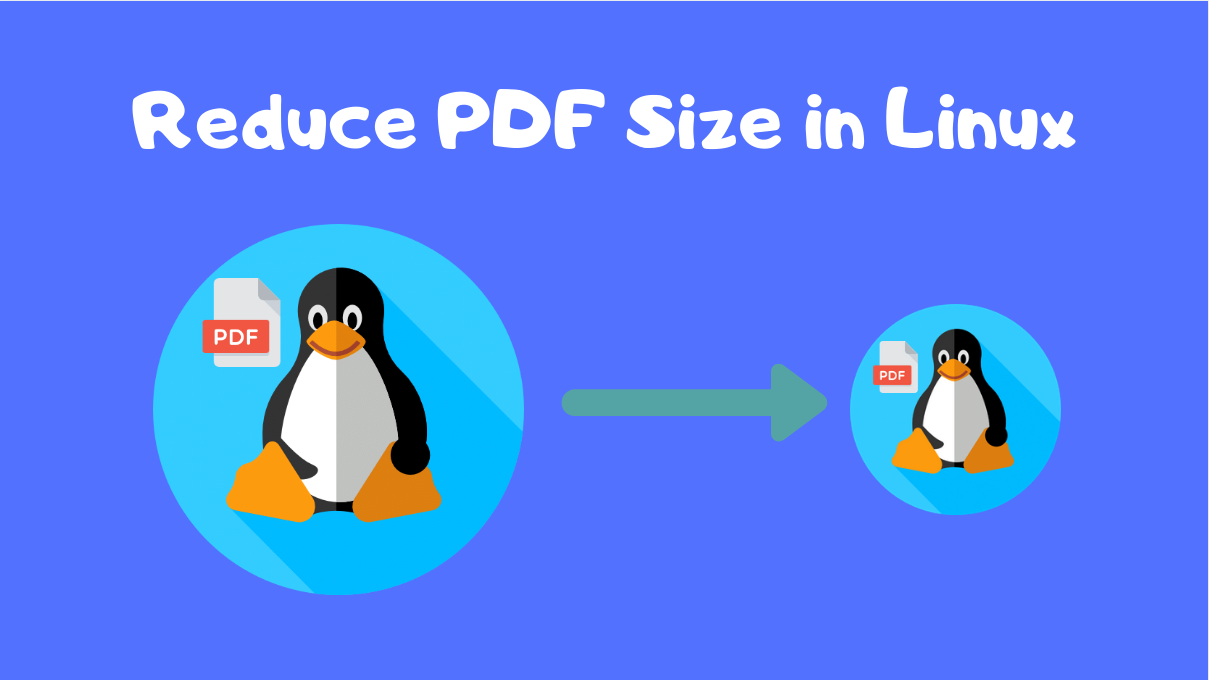- Log in to:
- Community
- DigitalOcean
- Sign up for:
- Community
- DigitalOcean

In our Linux system, If we have a large PDF file, we may want to reduce it’s size. We shall look at different ways to reduce PDF size or compress PDF files in Linux in this tutorial.
Let’s find out some Command Line and GUI methods to deal with this problem.
Command Line Utilities to Reduce PDF File Size in Linux
1. Using GhostScript
We can use the ghostscript command line utility in Linux to compress PDFs.
If the command is not available in your machine, you can install it using your package manager.
For example, in Ubuntu, you can use apt:
sudo apt install ghostscript
You can use this magic command to compress PDFs to a readable quality.
gs -sDEVICE=pdfwrite -dCompatibilityLevel=1.4 -dPDFSETTINGS=/screen -dNOPAUSE -dQUIET -dBATCH -sOutputFile=output.pdf input.pdf
Here, replace output.pdf and input.pdf accordingly.
The various tweaks to the -dPDFSETTINGS option are provided in the table below. Use them according to your need.
| -dPDFSETTINGS Option | Description |
-dPDFSETTINGS=/screen |
Has a lower quality and smaller size. (72 dpi) |
-dPDFSETTINGS=/ebook |
Has a better quality, but has a slightly larger size (150 dpi) |
-dPDFSETTINGS=/prepress |
Output is of a higher size and quality (300 dpi) |
-dPDFSETTINGS=/printer |
Output is of a printer type quality (300 dpi) |
-dPDFSETTINGS=/default |
Selects the output which is useful for multiple purposes. Can cause large PDFS. |
I have used the above command to achieve a compression from 73MB to 14MB!

2. Use ps2pdf
This command ps2pdf converts a PDF to PS and then again back, compressing it efficiently as a result.
It may not always work, but it can give very good results.
Format:
ps2pdf input.pdf output.pdf
It is recommended that you use the -dPDFSETTINGS=/ebooks setting to get the best performance, as ebooks have the best size for readability and also are small enough in size.
ps2pdf -dPDFSETTINGS=/ebook input.pdf output.pdf
I have tried this on a 73MB PDF and it had the same results as the ghostscript command, the compressed PDF having only 14MB!

GUI Utilities to Reduce PDF File Size in Linux
If you are uncomfortable with using command line tools, there is a GUI alternative as well.
Densify
This is a GUI front end to ghostscript, which can be installed in any Linux distribution, since it uses Python3 and it’s GTK modules.
This package is called Densify, and is available here(Link to github).
I have created a simple bash script to do all the necessary work. Run this bash script as root, to link and download necessary files.
#!/bin/bash
#- HELPER SCRIPT FOR DENSIFY
#- original package https://github.com/hkdb/Densify
#- script author Vijay Ramachandran
#- site https://journaldev.com
#-
# Go to your home directory (preferred)
cd $HOME
# Download the package
git clone https://github.com/hkdb/Densify
cd Densify
# Queue must be changed to queue in the file.
# Will not work otherwise
sed -i 's/Queue/queue/g' $PWD/densify
# Create the symlink to /opt
sudo ln -s $PWD /opt/Densify
# Perform the install
cd /opt/Densify
sudo chmod 755 install.sh
sudo ./install.sh
# Export to PATH
if [ $SHELL == "/bin/zsh" ]; then
if test -f $HOME/.zshrc; then
echo 'export PATH=/opt/Densify:$PATH' >> $HOME/.zshrc
source $HOME/.zshrc
else
echo "No zshrc Found! Please create a zsh config file and try again"
fi
else
if [ $SHELL == "/bin/bash" ]; then
if test -f $HOME/.bashrc; then
echo 'export PATH=/opt/Densify:$PATH' >> $HOME/.bashrc
source $HOME/.bashrc
else
if test -f $HOME/.bash_profile; then
echo 'export PATH=/opt/Densify:$PATH' >> $HOME/.bash_profile
source $HOME/.bash_profile
else
echo "No bashrc Found! Please create a bash config file and try again"
fi
fi
else
echo "Default Shell is not zsh or bash. Please add /opt/Densify to your PATH"
fi
fi
If there are no errors, you are good to go! Simply type the below command from opt/densify to invoke the GUI, or open it from your dashboard.
densify

You can now compress as many PDF files as you need, using a GUI!
Thanks for learning with the DigitalOcean Community. Check out our offerings for compute, storage, networking, and managed databases.
About the author
Still looking for an answer?
- Table of contents
- Command Line Utilities to Reduce PDF File Size in Linux
- GUI Utilities to Reduce PDF File Size in Linux
- Densify
- References
Deploy on DigitalOcean
Click below to sign up for DigitalOcean's virtual machines, Databases, and AIML products.
Become a contributor for community
Get paid to write technical tutorials and select a tech-focused charity to receive a matching donation.
DigitalOcean Documentation
Full documentation for every DigitalOcean product.
Resources for startups and SMBs
The Wave has everything you need to know about building a business, from raising funding to marketing your product.
Get our newsletter
Stay up to date by signing up for DigitalOcean’s Infrastructure as a Newsletter.
New accounts only. By submitting your email you agree to our Privacy Policy
The developer cloud
Scale up as you grow — whether you're running one virtual machine or ten thousand.
Get started for free
Sign up and get $200 in credit for your first 60 days with DigitalOcean.*
*This promotional offer applies to new accounts only.
